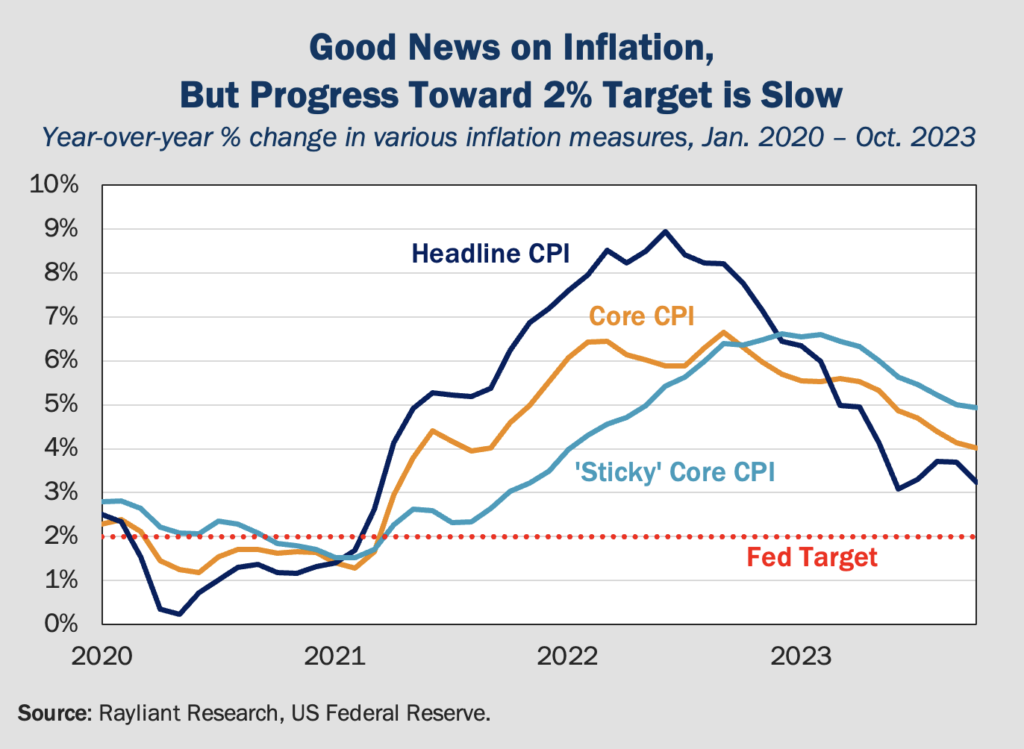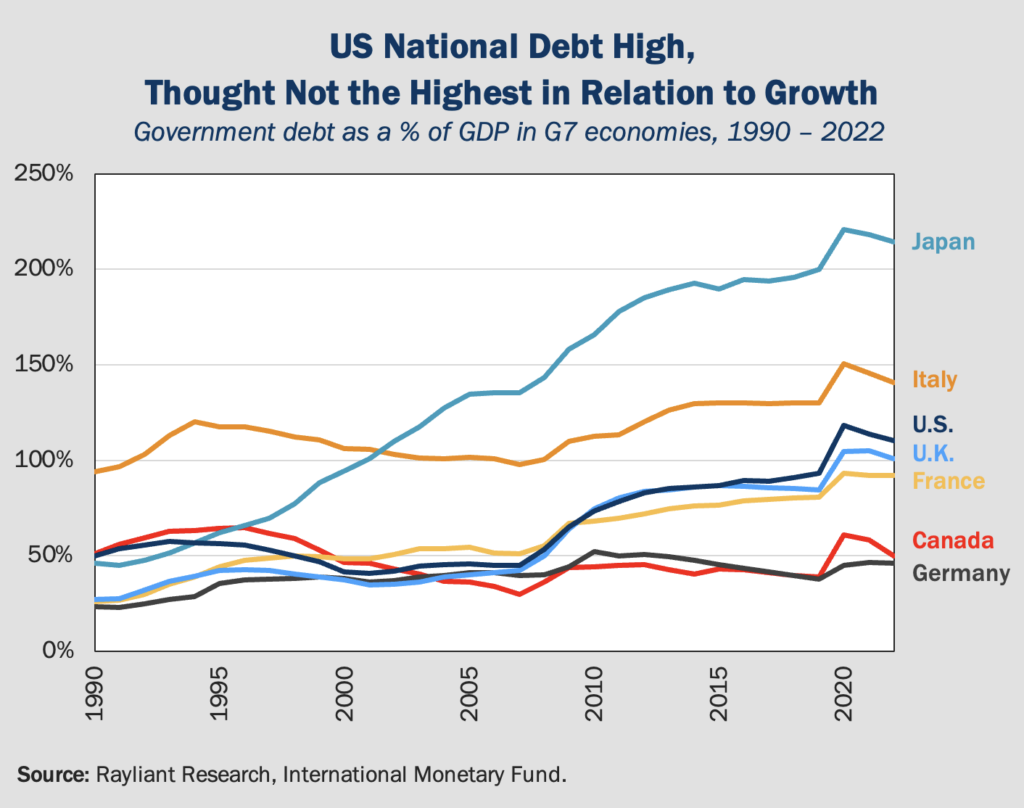
The CIO’s Take:
We’ve seen plenty of pundits in recent weeks declare “higher for longer” as dead in the water, and for many, last Tuesday’s surprisingly soft October CPI likely put the final nail in the coffin. There’s no doubt steady disinflation is good news for investors, so we believe markets were right to cheer October’s report, though we share the Fed’s concern around “head fakes” in inflation data, along with the central bank’s view the last bit of disinflation down to its 2% target could be the hardest to achieve. As long as growth remains strong and the labor market hasn’t cooled significantly more, we remain convinced the Fed will hold rates where they are, perhaps hiking again if data surprises in the other direction, and that Powell’s timetable for easing will very likely disappoint markets. On the one hand, that puts additional stress on the economy, as everyone from consumers to companies to governments struggles with higher borrowing costs. On the other hand, as Warren Buffett’s portfolio moves of the last year indicate, high interest rates allow investors to park capital in attractively yielding short-term US government paper—as we have—while waiting for better opportunities in the stock market.
October CPI surprises to the downside
Last Tuesday’s Bureau of Labor Statistics (BLS) report on US consumer prices showed inflation slowing significantly in October, coming in at 3.2% year-over-year, versus 3.7% just a month prior, and short of consensus expectations for a 3.3% increase. Given the Fed’s “data-driven” disposition, such strong softening of rising prices, in our view—and that of pretty much everyone else in the market—nixes any idea of a rate hike in December and gives the US central bank plenty of room to hold rates at their current high level in the interest of definitively stamping out inflation. Investors naturally loved the notion, bidding up policy-sensitive two-year Treasuries, which saw their yield drop by a whopping 0.2% on Tuesday; the dollar slumped 1.4% against a basket of major currencies. Stocks rallied, with the S&P 500 up 1.9% on Tuesday, the Nasdaq climbing 2.2%, and the smaller-cap Russell 2000 index, likewise more sensitive to macro stress, rocketing up 5.4% for the day.
Fed chair wary of CPI “head fakes”
Although BLS data last Tuesday reflect another month of progress, recent chatter from the Fed suggests we shouldn’t read too much into this beyond December extending the current pause in hikes. In the week prior to October’s favorable CPI, comments from Fed chair Jerome Powell made it clear the central bank’s “meeting-by-meeting” posture doesn’t imply quickly getting back to the Fed’s 2% target for inflation will be easy, with what Powell described as “head fakes” in the CPI representing a major risk of being “misled by a few good months of data.” Powell further suggested that much of the progress on inflation thus far has been a result of easing supply-side pressures—what we’ve always seen as “the easy part”—whereas lopping that final 1-2% off of inflation above the Fed’s target (see below) might “have to come from tight monetary policy restraining the growth of aggregate demand”.

How bullish should investors be?
Our take on October’s number is that it’s obviously good news, but investors should avoid extrapolating too far. As Powell’s comments indicate, data on rising prices are complex and subject to surprises—including those from volatile energy costs, which drove much of the progress on CPI for the month, declining by 2.5%. We also see support for the Fed’s concerns about the difficulty navigating this last bit of disinflation, as the plot above shows a clear transmission of inflationary pressure into “stickier-price” goods and services, which are softening more slowly. Moreover, a recent University of Michigan report on consumer sentiment showed households’ inflation expectations rising, something that has long concerned the Fed. All that said, it’s hard not to see sustained progress bringing down core CPI in the chart above, and while we don’t think easing is coming soon, which leaves us cautious, especially in light of lofty US stock valuations, October’s data certainly increase the odds that July’s hike was the Fed’s last of the cycle.
The US government borrows more than anyone
In last week’s Perspectives, we discussed how much US companies’ borrowing costs have risen since the Fed began hiking rates, and each one of us knows how onerous high interest rates can be for consumers (consider how few people are taking out new mortgages in today’s environment). But companies and consumers pale in comparison to governments in terms of the magnitude of their debt, and among sovereign borrowers, the US reigns supreme, totaling over $33 trillion as of last quarter.
Even as costs surge, America’s debt binge continues
Just like households, American politicians love to spend money, which was much less problematic when interest rates were near zero. Unfortunately, as rates shot up since early last year, the Treasury did nothing to curb its spending, and net interest expenses have risen to become one of the US government’s biggest outlays. The numbers involved are almost hard to fathom, with the US paying $659 billion in fiscal year 2023, ended in September, up $184 billion since last year, marking a 39% rise. Congressional Budget Office projections suggest that figure could hit $1.4 trillion in the next ten years, as government spending increases and tight Fed policy combine with concerns over America’s credit—which accounts for a large part of surging Treasury yields in recent months—to raise the US government’s borrowing costs dramatically.
From a growth standpoint, situation looks better
Of course, looking at the size of a nation’s debt or its borrowing costs in absolute dollar amounts can be a little misleading: what matters more is the size and cost of underwriting a country’s debt relative to the speed at which its economy is growing. Looking back at that $659 the US shelled out in net interest payments last year, we note that America also boasts the largest economy on the planet. US debt servicing costs last year only accounted for 2.45% of GDP. Similarly, while the US national debt as its largest versus GDP since 1998, it’s about middle of the pack vs. other G7 economies (see below).

Growing risk that high borrowing costs put a dent in growth
So where does all this leave us? Ultimately, we see the US national debt as another one of those areas in which the delayed impact of Fed policy could throw investors for a loop. That’s because low interest rates and big leverage have been one of the key drivers of growth over the last couple decades, such that even as nations’ debt ballooned, the costs of servicing it were tiny and gains in GDP—part of which that leverage was presumably promoting—offered fairly good justification for continuing to issue loads of debt. Now, on the other hand, with restrictive monetary policy pushing up companies’ borrowing costs, a hit to growth could make the figures in the chart above look much more daunting.
Berkshire can’t escape Q3 drawdown
Earlier this month, Berkshire Hathaway revealed its third-quarter results, posting a loss of $12.8 billion as its investment portfolio sagged amidst a broader market drawdown last quarter. While that headline number disappointed versus a loss of just $2.8 billion over the same period the year prior, the company’s operating earnings—which Buffet has often argued are a better sign of long-term success than short-term swings in the value of its stocks—climbed by 41% in Q3, reaching $10.8 billion, and reflecting the strength of the firm’s core businesses. Despite the portfolio’s recent drawdown, those businesses were worth quite a lot, indeed, with Berkshire’s holdings, including large positions in companies like Apple, Bank of America, and Chevron, worth a whopping $341 billion at the end of September.
Buffett doesn’t see much he likes
One thing many observers noted in Berkshire’s report was how the firm’s cash has swelled in recent quarters, as Buffett has struggled to find deals worth taking, with the hurdle for deploying cash rising with each Fed rate hike. At the end of September, Berkshire’s cash pile had reached a record $157 billion, bolstered by around $5.3 billion in net equity sales for the quarter. One stock Buffett did favor was Berkshire, itself, as the company recorded $1.1 billion in buybacks during Q3, bringing the year-to-date total to over $7 billion. Beyond that, the pickings were apparently slim, as sky-high stock valuations, even against a daunting macro backdrop, kept Buffett and team largely on the sidelines.
Berkshire holding dry powder in T-bills
And where has the Oracle of Omaha been parking his cash? The firm is reportedly heavy in short-term Treasuries, earning an easy 5% while holding plenty of dry powder to deploy—as Buffett has done routinely in the past—during times of market stress and public equity fire sales. As such, we deem ourselves to be in good company, with a portfolio similarly positioned since early last year. Like Mr. Buffett, we’ve seen stock valuations as rich and Treasury yields, by contrast, as unusually compelling. While we continue to spot sporadic bargains at the individual stock level, we believe risk management is paramount at this point in the cycle, and that there’s good chance the lagged effects of Fed policy deliver unpleasant surprises to the market going forward, and there will be much better opportunities to put capital to work as a result.
You are now leaving Rayliant.com
The following link may contain information concerning investments, products or other information.
PROCEED